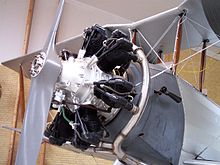Armstrong Siddeley Lynx

The Armstrong Siddeley Lynx was a piston aircraft engine made by the British manufacturer Armstrong Siddeley and intended for military, but also civilian use. The in 1920 presented air-cooled Siebenzylinder- OHV - radial engine was in a number of known British aircraft such as the Avro 504 N, O, Q and R, or the airspeed AS.5 incorporated A Courier. The Lynx also corresponded to the 14-cylinder double radial engine Armstrong Siddeley Jaguar released two years later in terms of dimensions and construction .
The first version of the Lynx still had a square bore-to-stroke ratio of 127 mm each, which resulted in a displacement of 11 liters. From the Lynx Mk I on, the stroke was increased to 139.7 mm, whereby the displacement increased to 12.4 liters. The performance was also continuously increased from the original 150 to 240 HP (Mk.IV C). The first engines still had cast aluminum pistons, but these were later replaced by forged ones. The cylinders with their cooling fins were made of steel, the cylinder heads of aluminum. Each had an inlet and an outlet valve. Most of the Lynx powered the propellers directly. The version Lynx IV (G) had a reduction gear with the ratio i = 1.522; this engine was used exclusively in the Blackburn F.2 Lincock II .
The Lynx remained in production until 1939. In total, over 6000 engines of this type were manufactured. A manufacturing license was granted to Alfa Romeo . Also known is this aircraft engine under license as Piaggio P.II .
Technical data (Lynx Mk.IV C)
| drilling | 127 mm |
| Hub | 139.7 mm |
| Displacement | 12.4 l |
| compression | 5.0: 1 |
| diameter | 1158 mm |
| Installation weight | 233.6 kg |
| Starting power | 240 hp at 2090 min -1 |
| Continuous output | 215 hp at 1900 min -1 |
literature
- Hans Giger: piston aircraft engines. Motorbuch-Verlag, Stuttgart 1986, ISBN 3-613-01089-5 .
- Alec Lumsden: British Piston Aero Engines and their Aircraft. ISBN 1853102946 .
- Bill Gunston: Lexicon of the aircraft engines. ISBN 361301422X .